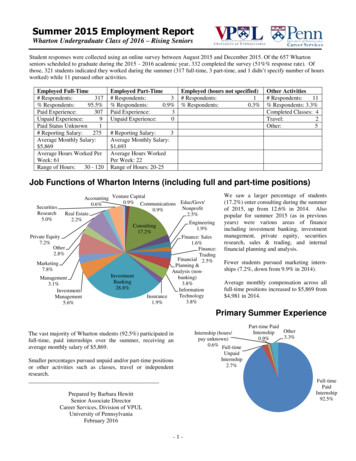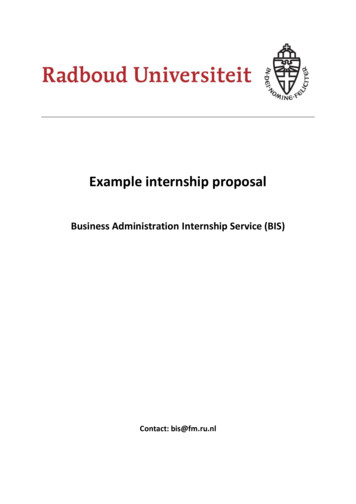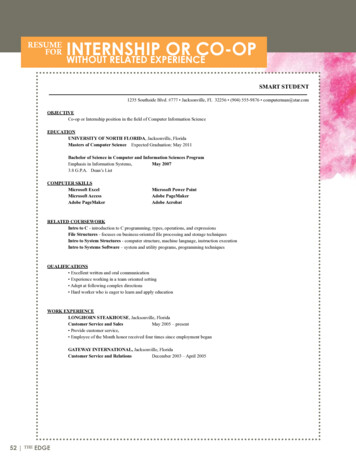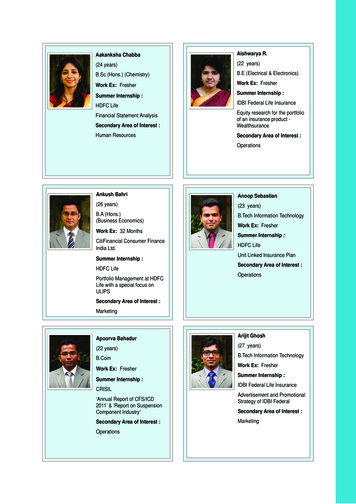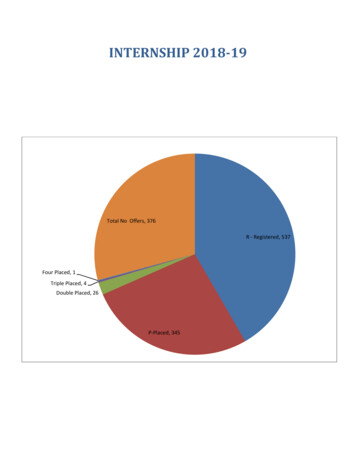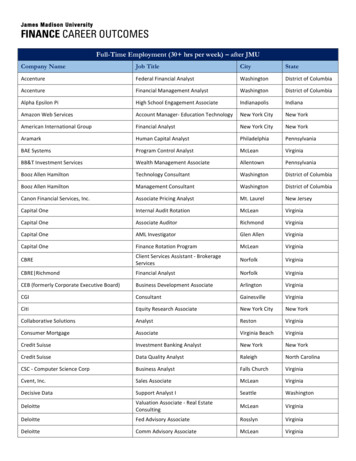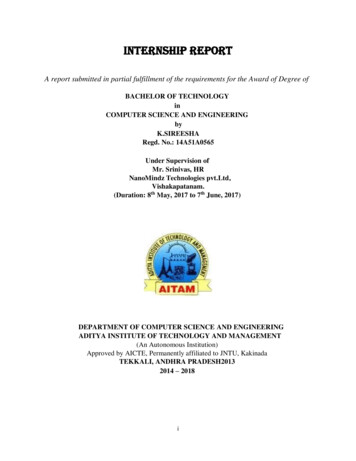
Transcription
INTERNSHIP REPORTA report submitted in partial fulfillment of the requirements for the Award of Degree ofBACHELOR OF TECHNOLOGYinCOMPUTER SCIENCE AND ENGINEERINGbyK.SIREESHARegd. No.: 14A51A0565Under Supervision ofMr. Srinivas, HRNanoMindz Technologies pvt.Ltd,Vishakapatanam.(Duration: 8th May, 2017 to 7th June, 2017)DEPARTMENT OF COMPUTER SCIENCE AND ENGINEERINGADITYA INSTITUTE OF TECHNOLOGY AND MANAGEMENT(An Autonomous Institution)Approved by AICTE, Permanently affiliated to JNTU, KakinadaTEKKALI, ANDHRA PRADESH20132014 – 2018i
DEPARTMENT OF COMPUTER SCIENCE AND ENGINEERINGADITYA INSTITUTE OF TECHNOLOGY AND MANAGEMENT(An Autonomous Institution)TEKKALICERTIFICATEThis is to certify that the “Internship report” submitted by K.SIREESHA(Regd. No.:14A51A0565) is work done by her and submitted during 2017 – 2018 academic year, in partialfulfillment of the requirements for the award of the degree of BACHELOR OF TECHNOLOGY inCOMPUTER SCIENCE AND ENGINEERING, at NanoMindz Technologies pvt.Ltd,Vishakapatanam.College Internship CoordinatorDr. B. Rajesh.Department Internship CoordinatorSri L.V. Satyanarayana, M.Tech.Assistant professor, CSEDr.G.S.N.MurthyM. Tech.,Ph.D.Head of the DepartmentDepartment of CSEii
iii
ACKNOWLEDGEMENTFirst I would like to thank Mr.Srinivas, HR, Head, of NANOMINDZ,Vishakapatanam for giving me the opportunity to do an internship within theorganization.I also would like all the people that worked along with me NANOMINDZ,Vishakapatanam with their patience and openness they created an enjoyable workingenvironment.It is indeed with a great sense of pleasure and immense sense of gratitude that Iacknowledge the help of these individuals.I am highly indebted to Director Prof.V.V. NageswaraRao and Principal Dr. K.B. MadhuSahu, for the facilities provided to accomplish this internship.I would like to thank my Head of the Department Dr. G.S.N.Murthy for hisconstructive criticism throughout my internship.I would like to thank Dr. B. Rajesh, College internship coordinatorSri.L.V Satyanarayana internship coordinator Department of CSE for their support andadvices to get and complete internship in above said organization.I am extremely great full to my department staff members and friends who helpedme in successful completion of this internship.K.SIREESHA(14A51A0565)iv
ABSTRACTBusiness intelligence (BI) systems depend on efficient integration of disparate and oftenheterogeneous data. The integration of data is governed by data-intensive flows and is driven bya set of information requirements. Designing such flows is in general a complex process, whichdue to the complexity of business environments is hard to be done manually. In this paper, wedeal with the challenge of efficient design and maintenance of data-intensive flows and proposean incremental approach, namely Co Al, for semi-automatically consolidating data-intensiveflows satisfying a given set of information requirements. Co Al works at the logical level andconsolidates data flows from either high-level information requirements or platform-specificprograms. As Co Al integrates a new data flow, it opts for maximal reuse of existing flows andapplies a customizable cost model tuned for minimizing the overall cost of a unified solution. Wedemonstrate the efficiency and effectiveness of our approach through an experimental evaluationusing our implemented prototype.Organisation Information:NANOMINDZ is a professionally managed company with years of industry experience indeveloping and delivering Enterprise specific Software and Web development solutions usinglatest technologies. Quality is the buzz word in today's world without which no organization cansurvive. Along with quality we at NANOMINDZ. "Think Beyond" to take one step ahead andfocus on Delivery of the solutions. We design processes that focus not just only on quality butalso on delivery which increases the value to our global clients. Apart from training ouremployees on latest technologies, we also empower them to deliver exciting solutions to ourclients. At the core NANOMINDZ operates in three specific domains namely SoftwareDevelopment, Website Design & Development and Geographic Information Services. We alsooffer our services in building E-Commerce solutions, Search Engine Optimization (SEO) andDatabase Administration services. Under each division we further provide specific industrysolutions on focused domains with cutting edge technologies. We emphasize on buildingrelationships with our clients by delivering projects on time and within budget.Programs and opportunities:This ground up approach helps us deliver not only the solution to our clients but also add valueto At the core NANO MINDZ operates in three specific domains namely Software Development,Website Design& Development and Geographic Information Services. We also offer ourservices in building E-Commerce solutions, Search Engine Optimization (SEO) and DatabaseAdministration services. Under each division we further provide specific industry solutions onfocused domains with cutting edge technologies. We emphasize on building relationships withour clients by delivering projects on time and within budget.v
Methodologies:We follow a structured methodology for our projects which starts from designing the solution tothe implementation phase. Well planned Project reduces the time to deliver the project and anyadditional ad-hoc costs to our clients, hence we dedicate majority of our time understanding ourclients business and gather requirements. This ground up approach helps us deliver not only thesolution to our clients but also add value to your investments.Key parts of the report:Under each division we further provide specific industry solutions on focused domains withcutting edge technologies.Benefits of the Company/Institution through our report:Under each division we further provide specific industry solution on focused domains withcutting edge technologies. We emphasize on building relationships with our clients by deliveringprojects on time and within budget.vi
INDEXS.no1.CONTENTSPage noIntroduction .11.1 Modules .22.Analysis .33.Software requirements specifications .44.Technology 54.1 ASP.NET .54.2 ADP.NET .64.3 C#.NET .74.4 JAVA .74.5 SQL Data Base . 85.Coding .106.Screenshots.117.Conclusion .168.Bibilography .17vii
Learning Objectives/Internship Objectives Internships are generally thought of to be reserved for college students looking to gainexperience in a particular field. However, a wide array of people can benefit fromTraining Internships in order to receive real world experience and develop their skills. An objective for this position should emphasize the skills you already possess in the areaand your interest in learning more Internships are utilized in a number of different career fields, including architecture,engineering, healthcare, economics, advertising and many more. Some internship is used to allow individuals to perform scientific research while othersare specifically designed to allow people to gain first-hand experience working. Utilizing internships is a great way to build your resume and develop skills that can beemphasized in your resume for future jobs. When you are applying for a TrainingInternship, make sure to highlight any special skills or talents that can make you standapart from the rest of the applicants so that you have an improved chance of landing theposition.viii
1st WEEKDATEDAY8/05/17Monday9/05/17Tuesday10/05/17 Wednesday11/05/17 Thursday12/05/17Friday13/05/17 SaturdayNAME OF THE TOPIC/MODULE COMPLETEDIntroduction of .NET frame workFeatures of .NET { IDE,CLR,CTS}Introduction of C# .NETIntroduction of console applicationContinuing console applicationsUnderstanding different types of class and collection2nd WEEKWEEKLY OVERVIEW OF INTERNSHIP ACTIVITIESDATEDAY15/05/17 Monday16/05/17 Tuesday17/05/17 Wednesday18/05/17 Thursday19/05/17Friday20/05/17 SaturdayNAME OF THE TOPIC/MODULE COMPLETEDIntroduction to windows applicationUnderstanding controls like [label, button] etc.,Continuing understanding controlsIntroduction to windows servicesContinuing windows servicesIntroduction to class librariesix
3rd 9/05/17 Monday30/05/17 Tuesday31/05/17 Wednesday01/06/17 Thursday02/06/17 Friday03/06/17 Saturday5th WEEK25/05/174th WEEKDATEDAY22/05/17 Monday23/05/17 Tuesday24/05/17 WednesdayNAME OF THE TOPIC/MODULE COMPLETEDIntroduction .NET REMOTINGIntroduction to web programmingUnderstanding what is Internet website, web request andweb responseUnderstanding client side web technologies VS server sideweb technologiesIntroduction to HTMLHTML continuedNAME OF THE TOPIC/MODULE COMPLETEDUnderstanding classic ASP VS ASP.NETIntroduction to ASP.NET web server controlsWorking with different web server controlsStandard controls , validation controlsIntroduction to data control in depthProject sessionDATEDAYNAME OF THE TOPIC/MODULE COMPLETED05/06/17 MondayDesign& Analysis06/06/17 TuesdayCoding07/06/17 WednesdayTestingx
1. INTRODUCTIONThe complexity of business environments constantly grows, both with regard to the amountof data relevant for making strategic decisions and the complexity of included businessprocesses. Today’s dynamic and competitive markets often imply rapid (e.g., near real-time)and accurate decision making. Relevant data are stored across a variety of data repositories,possibly using different data models and formats, and potentially crossed with numerousexternal sources for various context aware analysis. A data integration process combines dataresiding on different sources and provides unified view of this data for a user [1]. Forexample, in a data warehousing (DW) context, data integration is implemented throughextract-transformthat extracts, cleans, and transforms data from multiple, oftenheterogeneous data sources and Finally, delivers data for further analysis. There are variouschallenges related to data Flow design. Here we consider two: design evolution and designcomplexity.A major challenge that BI decision-makers face relates to the evolution of businessrequirements. These changes are more frequent at the early stages of a DW design project andin part, this is due to a growing use of agile methodologies in data Flow design and BIsystems in general. But changes may happen during the entire DW lifecycle. Having an upand-running DW system satisfying an initial set of requirements is still a subject to variouschanges as the business evolves. The data Flows populating a DW, as other softwareArtefacts, do not lend themselves nicely to evolution events and in general, due to theircomplexity, maintaining them manually is hard. The situation is even more critical in today’sBI settings, where on-the-fly decision making requires faster and more efficient adapting tochanges. Changes in business needs may result in new, changed or removed informationrequirements. Thus having an incremental and agile solution that can automatically absorboccurred changes and produce a Flow satisfying the complete set of requirements wouldlargely facilitate the design and maintenance of data-intensive Flows.In an enterprise environment data is usually shared among users with varying technical skillsand needs, involved in different parts of a business process. Typical real-world data-intensiveworkloads have high temporal locality, having 80% of data reused in a range from minutes tohours. However, the cost of accessing these data, especially in distributed scenarios, is oftenhigh. At the same time, intertwined business processes may also imply overlapping of dataprocessing. For instance, a sales department may analyze the revenue of the sales for the pastyear, while Finance may be interested in the overall net profit. Computing the net profit canlargely benefit from the total revenue already computed for the sales department and thus, itcould benefit from the sales data Flow too. The concept of reusing partial results is not new.Software and data reuse scenarios in data integration have been proposed in the past, showingthat such reuse would result in substantial cost savings, especially for large, complex businessenvironments. Data Flow re use could result in a significant reduce in design complexity, butalso in intermediate Flow executions and thus, in total execution time too.1
1.1Module Description:Shopper: 1) User registers the site.2) Products will be showed3) If user selected the product and then save4) User selected product is send to the Order.5) If user wants to buy the product they can also buy.Supplier 1) send product details2) send payment verification3) Store buying detail4) Store line items using join product and orderOrder 1) Store all the user details.2) Order detail2
2. SYSTEM ANALYSIS2.1 Requirement AnalysisExisting System:In an Existing we address these challenges and present an approach to efficient, incrementalconsolidation of data-intensive flows. Following common practice, our method iterates overinformation requirements to create the final design. we show how to efficiently accommodatea new information requirement to an existing design and also, how to update a design in lieuof an evolving information requirement. The final design satisfying all requirementscomprises a multi-flow. As ‘coal’ is formed after the process and extreme compaction oflayers of partially decomposed materials1, Co Al processes individual data flows andincrementally consolidates them into a unified multi-flow.Proposed SystemFollowing the previously proposed set of flow transformations in the context of ETLprocesses in Co Al we extend this set considering also the associative property of n-arrayoperations (e.g., Join) and thus rely on the following four flow transformations used forreordering the operations. Swap Applied to a pair of adjacent unary operations, itinterchanges the order of these operations.Distribute/Factorize. Applied on a unaryoperation over an adjacent n-array operation, it respectively distributes the unary operationover the adjacent nary operation or factorizes several unary operations over the adjacent narray operation. Merge/Split. Applied on a set of adjacent unary operations, it respectivelymerges several operations into a single unary operation or splits a unary operation intoseveral unary operations. Re-associate. Applied on a pair of mutually associative n-arrayoperations, it interchanges the order in which these operations are executed.3
3. SOFTWARE REQUIREMENTS SPECIFICATIONS3.1 System configurationsThe software requirement specification can produce at the culmination of the analysis task.The function and performance allocated to software as part of system engineering are refinedby established a complete information description, a detailed functional description, arepresentation of system behavior, and indication of performance and design constrain,appropriate validate criteria, and other information pertinent to requirements.Software Requirements: Operating system: Windows 7 Ultimate. Coding Language: MVC 4 Razor Front-End: Visual Studio 2012 Professional. Data Base: SQL Server 2008.Hardware Requirement: System: Pentium IV 2.4 GHz. Hard Disk: 1TB. Ram: 4GB.4
4. TECHNOLOGY4.1 ASP.NETASP.NET is a web development platform, which provides a programming model,a comprehensive software infrastructure and various services required to build up robust webapplications for PC, as well as mobile devices.ASP.NET works on top of the HTTP protocol, and uses the HTTP commands andpolicies to set a browser-to-server bilateral communication and cooperation.ASP.NET is a part of Microsoft .NET platform ASP.NET applications arecompiled codes, written using the extensible and reusable components or objects present in.NET framework. These codes can use the entire hierarchy of classes in .NET framework.ASP.NET web forms extend the event-driven model of interaction to the webapplications. The browser submits a web form to the web server and the server returns a fullmarkup page or HTML page in response.All client side user activities are forwarded to the server for tasteful processing.The server processes the output of the client actions and triggers the reactions.Now, HTTP is a stateless protocol. ASP.NET framework helps in storing the informationregarding the state of the application, which consists of: Page stateSession stateThe page state is the client state, i.e., the content of various input fields in theweb form. The session state is the collective information obtained from various pages theuser visited and worked with, i.e., the overall session state. To clear the concept, let us takean example of a shopping cart.User adds items to a shopping cart. Items are selected from a page, say the itemspage, and the total collected items and price are shown on a different page, say the cart page.Only HTTP cannot keep track of all the information coming from various pages. ASP.NETsession state and server side infrastructure keeps track of the information collected globallyover a session.5
The ASP.NET runtime carries the page state to and from the server across pagerequests while generating ASP.NET runtime codes, and incorporates the state of the serverside components in hidden fields.This way, the server becomes aware of the overall application state and operatesin a two-tiered connected way.The ASP.NET component model provides various building blocks of ASP.NETpages. Basically it is an object model, which describes:ASP.NET is a technology, which works on the .NET framework that containsall web-related functionalities. The .Net frame work is made of an object-oriented hierarchy.An ASP.NET web applications is made of pages. When a user requests an ASP.NET page,the IIS delegates the processing of the page to the ASP.NET runtime system.The ASP.NET runtime transforms the .aspx page into an instance of a class,which inherits from the base class page of the .Net framework. Therefore, each ASP.NETpage is an object and all its components i.e., the server-side controls are also objects.4.2 ADO.NETAs you develop applications using ADO.NET, you will have differentrequirements for working with data. In some cases, you might simply want to display data ona form. In other cases, you might need to device a way to share information with anothercompany.No matter what you do with data, there are certain fundamental concepts that youshould understand about the data approach in ADO.NET. You might never need to knowsome of the details of data handling- for example, you might never need to directly edit anXML file containing data- but it is very useful to understand the data architecture inADO.NET, what the major data components are, and how the pieces fit together.This introduction presents a high-level over view of these most importantconcepts. The topic deliberately skips over many details- for example, there is much more todata sets than what is mentioned here- in favour of simply introducing you to ideas behind thedata integration in ADO.NET.ADO.Net does not continuously live connections. In traditional client/serverapplications, components establish a connection to a data base and kept it open while theapplication is running. For a variety of reasons, this approach is impractical in manyapplications.Open database connections take up valuable system resources. In most cases,databases can maintain only a small number of concurrent connections. The overhead ofmaintaining these connections detracts from overall application performance.6
Similarly, applications that require an open database connection are extremelydifficult to scale up. An application that does not scale up well might perform acceptable withfour users but will likely not do so with hundreds.ASP.NET Web applications in particularneed to be easily scalable, because traffic to a website can go up by orders of magnitude in ashort period.A model based on always connected data can make a difficult and impractical toexchange data across application and organizational boundaries using a connectedarchitecture. If two components need to share the same data, both have to be connected, and away must be devised for the components to pass data back and forth.For all the reasons, data accessed with ADO.NET is designed around anarchitecture that uses connections sparingly. Applications are connected to the database onlylong enough to fetch or update the data. Because the database is not holding onto connectionsthat are largely idle, it can service many more users.4.3 Overview of C#.Net C# is a simple, modern, object oriented, and type –safe programming language derived fromC and C . It will immediately be familiar to C and C programmers. C# aims to combine the high productivity of visual basic and the raw power of C Visual C#.NET is Microsoft’s C# development tool. It includes an interactive development environment, visual designers for building windowsand web applications, a compiler and a debugger. Visual C#.NET is part of a suite of products, called Visual Studio .NET, that also includesVisual Basics .NET, Visual C .NET and the Jscript scripting language. The .NET frame work defines a “Common Language Specification” (CLS), a short of linguafranca that ensures seamless interoperability between CLS-complaint languages and classlibraries. For C# developers this means even though C# is a new language, it has complete access tothe same rich class libraries that are used by seasoned tools such as Visual Basic.NET andVisual C .NET.4.4 JAVAJavaScript is an interpreter, client-side, event-based, object oriented scripting language thatyou can use to add dynamic interactivity to your web pages.JavaScript scripts are written in plain text, like HTML, XML, Java, PHP and just about anyother modern computer code. In this code, we will use Windows Note Pad to create and editour JavaScript code, but there are a large number of alternatives available.Note Pad is chosen to demonstrate JavaScript’s immediacy and simplicity.You can use JavaScript to achieve any of the following:7
Create special effects with images that give the impression that a button is either highlightedor depressed whenever the mouse pointer is hovered over it. Validate information that users enter into your web forms Open pages in new windows, and customise the appearance of those new windows. Detect the capabilities of the user’s browser and alter your page’s content appropriately. Create custom pages “on the fly” without the need for a server-side language like PHP.JavaScript is not Java, though if you come from a Java background, you will notice that bothlanguages look similar when written. Java is a full featured and comprehensive programminglanguage similar to C or C , and although JavaScript can interact with Java webapplications, the two should not be confused.Different web browsers will run your JavaScript in different, sometimes incompatibleways. In order to work around this, it is often necessary to use JavaScript itself to detect thecapabilities of the browser in which it finds itself, and alter its operation depending on theresult.To revisit the original definition in this chapter, note the following points: Interpreted refers to the fact that JavaScript code is executed (acted on) as it is loaded intothe browser. This is a change of pace from compiled languages like Java, which check yourprogram thoroughly before running a single line of code, and can have many implicationsthat can catch you out if you are from a non-interpreted programming background. Client-side has been defined already in the previous chapter. Event-based refers to JavaScript’s ability to run certain bits of code only when a specifiedevent occurs. An event could be the page being loaded, a form being submitted, a link beingclicked, or an image being pointed at by a mouse pointer. Object-oriented signals that JavaScript’s power to exert control over an HTML page isbased on manipulating objects within that page. If you are familiar with object-oriented programming, you will be aware of some of thepower that this can bring to the coding environment.4.5 DATABASEAbout Microsoft SQL Server 2008Microsoft SQL server is a Structured Query Language (SQL) base, client/serverrelational database. Each of these terms describes a fundamental part of the architecture ofSQL server.8
A database is similar to a data file in that it is storage place for data. Like a datafile, a database does not present information directly to a user, the user runs an applicationthat accesses data from the database and presents it to the users in an untreatable format. Adatabase typically ha two components: the files holding the physical database access data.The DBMS is responsible for enforcing database structure, including: Maintaining the relationships between data in the database.Ensuring that data is stored correctly, and the rules that defining data relationships are notviolated.Recovering all data to a point of known consistency in case of system failures.Relational DatabaseThere are different ways to organize data in a database but relational databases areone of the most effective. Relational database systems are an application of mathematical settheory to the problem of effectively organizing data. In a relational database is collected intotables called relations in relation theory.When organizing data into tables, you can usually find many different ways todefine tables. Relational database theory defines a process, normalization, which ensures thatthe set of tables you define will organize our data effectively.Client/ServerIn Client/Server system the server is a relatively large computer in a centrallocation that manages a resource used by many people. When individuals need to use theresource, they connect over the network from their computers, or clients, to the server.Examples of servers are: In Client/Server database architecture, the database files and DBMSsoftware resides on a server. A communications component is provided so applications canrun on separate clients and communicate to the database server over a network. The SQLserver communication component also allows communication between an applicationrunning on the server and SQL server.Server applications are usually capable of working with several clients at the sametime. SQL server can work with thousands of client applications simultaneously. The serverhas features to prevent the logical problems that occur if a user.While SQL server is design to work as a server in a Client/Server network, it isalso capable of working as a stand-alone database directly on the client. The scalability andease of use features of SQL server allows it to work efficiently on a client without consumingtoo many resource.Structured Query Language (SQL)9
To work with data in a database, you must use a set of commands and statements(language) defined by the DBMS software. There are several different languages that can beused with relational database; the most common is SQL. Both the American nationalstandards institute (ANSI) and the International Standards Organization (ISO) has definedstandards for SQL.10
5. CODINGRegistration Form %@ Page Title "" Language "C#" MasterPageFile " /MasterPage.master"AutoEventWireup "true" CodeFile "reg.aspx.cs" Inherits "reg" % asp:Content ID "Content1" ContentPlaceHolderID "head" Runat "Server" style type "text/css" .style2{width: 57%;} /style /asp:Content asp:Content ID "Content2" ContentPlaceHolderID "ContentPlaceHolder1"Runat "Server" table class "style2" align "center" tr td colspan "2" style "text-align: center" strong User Registration Form /strong /td /tr tr td Name /td td asp:TextBox ID "TextBox1" runat "server" /asp:TextBox /td /tr tr td Email /td td asp:TextBox ID "TextBox2" runat "server" /asp:TextBox /td /tr tr td Mobile /td td asp:TextBox ID "TextBox3" runat "server" /asp:TextBox /td /tr tr td Gender /td td asp:RadioButtonList ID "RadioButtonList1" runat "server"RepeatDirection "Horizontal" asp:ListItem Male /asp:ListItem 11
asp:ListItem Female /asp:ListItem /asp:RadioButtonList /td /tr tr td UserId /td td asp:TextBox ID "TextBox4" runat "server" /asp:TextBox /td /tr tr td Password /td td asp:TextBox ID "TextBox5" runat "server" /asp:TextBox /td /tr tr td asp:Label ID "Label1" runat "server" style "font-weight: 700" /asp:Label /td td asp:Button ID "Button1" runat "server" onclick "Button1 Click"Text "Register" / /td /tr /table br / br / br / /asp:Content 12
MasterPage %@ Master Language "C#" AutoEventWireup "true" CodeFile "MasterPage.master.cs"Inherits "MasterPage" % !DOCTYPE html PUBLIC "-//W3C//DTD XHTML 1.0 xhtml1-transitional.dtd" html xmlns "http://www.w3.org/1999/xhtml" head runat "server" title /title asp:ContentPlaceHolder id "head" runat "server" /asp:ContentPlaceHolder style type "text/css" .style1{width: 100%;border: 1px solid #0000FF;background-color: #FFFFFF;} /style /head body bgcolor "skyblue" form id "form1" runat "server" table class "style1" tr td asp:Image ID "Image1" runat "server" Height "312px" Width "883px" / /td /tr tr td asp:Menu ID "Menu1" runat "server" Orientation "Horizontal"style "font-weight: 700" DynamicMenuStyle HorizontalPadding "60px" VerticalPadding "50px"Width "1000px" / Items asp:MenuItem Text
(Duration: 8th May, 2017 to 7th June, 2017) DEPARTMENT OF COMPUTER SCIENCE AND ENGINEERING ADITYA INSTITUTE OF TECHNOLOGY AND MANAGEMENT (An Autonomous Institution) Approved by AICTE, Permanently affiliated

